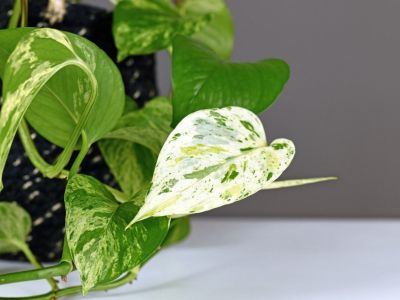Chimeral Variegation in Plants
There are several ways variegation may occur in plants. Plants, just like humans, contain stem cells. In the case of plants, the stem cell is called a meristem. In variegated plants the meristem is a combination of green and albino cells that result in green and white striping or variegation. The albino cells do not make chlorophyll, while the green cells do. If the meristem is variegated, the plant is genetically normal and is referred to as chimeral variegation. Chimeral variegation is the most common type of variegation and because it is a natural occurrence can be propagated via stem cutting; however, this chimeral variegation cannot be propagated through seeds, leaf, or root cuttings. The plant will propagate but the variegation will not appear.
Other Types of Variegation in Plants
Some plants are just naturally patterned and are referred to as natural or pigmented variegation.An example of this type of variegations is Calathea lancifolia. This type of variegation can be passed on. Blister variegation or reflective variegation is when air pockets are found in both uncolored upper and pigmented lower layers. An example of this is Scindapsus pictus. Mutations of the chloroplast genome may interrupt chlorophyll production resulting in variegating foliage. Viruses such as Mosaic virus can also cause variegation. Less common than the other types of variegation, this type can be seen in some Hosta cultivars. Lastly, variegation may be forced or introduced by chemicals, x-rays, poisons, or antibiotics. In the case of chemically induced variegation, plants are often weak and difficult to care for plus the mutation is not inherited and prone to reversion, a term referring to loss of variegation.
Can you Encourage Variegation in Plants?
While it is difficult and time consuming to create a variegated plant, plants that currently have the mutation can be encouraged to become more variegated. Variegated plants are often sensitive to shifts in light. Since the white foliage areas do not absorb chlorophyll, the plant needs to be in the sun. As the seasons change, sunlight shifts. This may mean your plant needs to be moved to a window that receives more sunlight, or get supplemental light. You can also prevent a variegated plant that is reverting from taking over the entire plant by removing any solid green leaves. If these leaves remain the green color can overtake the variegated part of the plant turning it all green. If your heart is set on propagating a variegated plant, your best chance is by propagating a genetically variegated plant of parts of a plant with mutated plant cells that lack green pigment. Also, the only way to encourage variegation in a non-mutated plant is to put the plant into chlorophyll degradation using certain herbicides; a practice that is not guaranteed and will likely kill the plant.
